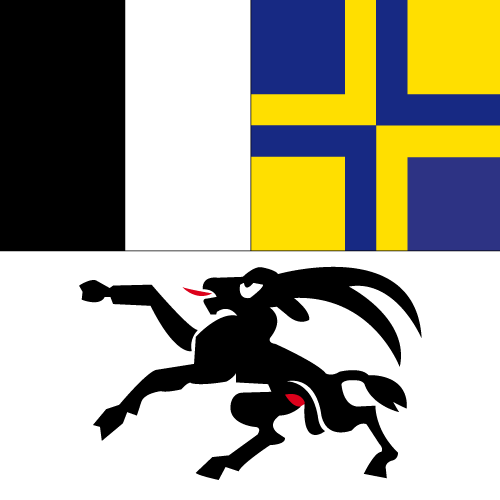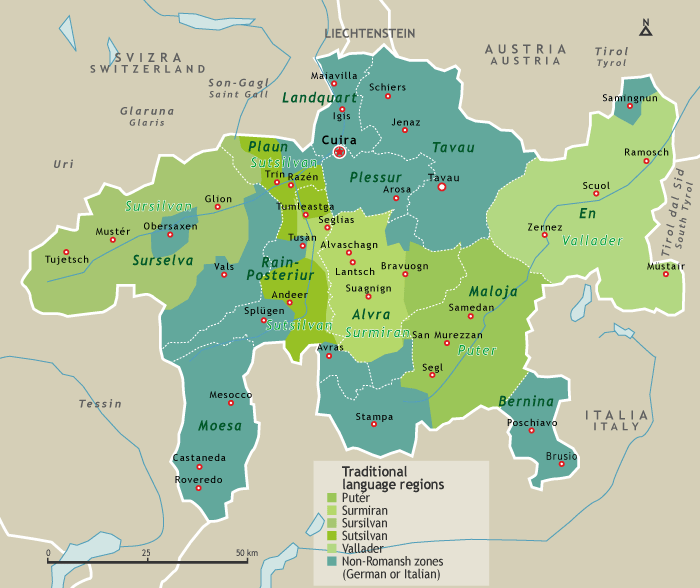Romansh, the poor Swiss relative

Although the term stateless nation is questionable in the case of the Romansh, these Rhaeto-Romance people in the Alpine region are distinguished by their language. They are related to the Ladins and the Friulians. Since the end of the Roman Empire they have been part of the canton of Grisons. However, their territory has been greatly eroded.

Thus, the Romansh do not claim their own territory, but populate many valleys of the canton of Grisons. They are scattered into five regions. The remainder of the population speaks German or Italian. The Romansh have only recently obtained the use of their own language.
Descendants of Latin populations, the Romansh were able to preserve their culture because of their location in the heart of the Alps. Under the pressure of Walser populations, originally German speakers of Vallais, their territory has been largely eroded, leaving the place to a multi-cultural community.
Since 1938, Romansh has had the status of a national language in Switzerland, without the benefit of an official status. It took the efforts of many associations in 1996 to get it. Thus, surprisingly, without claiming any territory, the Romansh can teach their language by immersion in all primary schools, with German being gradually introduced.
Unfortunately, the small Romansh community faces the exodus of its citizens: 40% of the Romansh population live outside the traditional territory. Maintaining the language is difficult in these conditions. Romansh consciousness is beginning to emerge in recent years, however, especially through relations with their Rhaeto-Romance neighbours.

Identity card

| Name | Rumantschs dal Grischun | Romansh Romantschen in Graubünden | German Romanci dei Grigioni | Italian (Romansh of Grisons) |
| Population | 198,379 inhab. (2018) (including 33,991 Romansh in 2013) |
| Area | 7,105 km² |
| Languages | Rumantsch | Romansh Deutsch | German Italiano | Italian (official) |
| Number of native speakers | 60,000 | Romansh (44,354 as main language) (2017) |
| State of guardianship | Switzerland |
| Official status | Canton |
| Capital | Cuira | Romansh Chur | German Coira | Italian (Coire) |
| Historic religion | Roman Catholic and Protestant |
| Flag | Bandiera dal Grischun | Romansh (Flag of the Grisons) |
| Anthem | None |
| Motto | None |

Timeline

- 15 BC • The Romans conquer the Rhaetic territory. Appearance of the Rhaeto-Romance language and culture, strongly influenced by Latin.
- 1464 • After the Great Fire of Chur, the capital of the Canton of Grisons, the town is completely Germanised.
- 16th–17th century • The Reformation stimulates the use of a written Romansh language.
- 19th century • Increased awareness of the value of the Romansh culture.
- 1938 • Romansh becomes the national language.
- 1996 • Romansh becomes an official language in Switzerland.
- 1997 • Ratification of the European Charter for Regional and Minority Languages, allowing an increased presence of Romansh in public life.
- 2007 • The Canton of Grisons engages in the development of a real language policy in favour of the Romansh language.

Brief history

Romansh (Rumantsch grischun), is recognised as one of the four Swiss languages (with some exceptions) since the official vote of 1996. The Lia Rumantscha largely participated in this dynamic. A body established in 1919, it aims to disseminate the Romansh language throughout public life. It is particularly through the efforts of language standardisation (i.e. finding a common base for different varieties in the area) that the preservation of the Romansh language is now possible. Since 2003, the Cantonal parliament of Grisons has established Romansh as a written language in all schools, which has allowed the publication of a number of handbooks. This rebirth is due to a voluntary policy by the authorities of the Canton of Grisons and the fact that the language has been made official. Multilingual Switzerland proves that its model of preserving a minority language is effective.

Geography

Surrounded by Austria, Liechtenstein, Italy and the cantons of Uri, St Gall and Glaris, the canton of Grisons was initially populated by Celts. This particular area of south east Switzerland lies entirely in the Alps, St Moritz and Davos being two of the most well-known ski resorts in the world. This Alpine landscape also explains the low population density, which is 26 inhabitants per km². Largely populated by German speakers in the north and Italian speakers in the south, only the central part extending from the borders of Uri to those of the Tyrol speak Romansh, the native Rhaeto-Roman language. Widely dispersed and living in Alpine valleys, the Romansh are still seeing their territory shrink. For example, Chur, the Canton capital, is now largely populated by German speakers. Five linguistic regions make up the Romansh territory: from west to east – Surselvan, Sutsilvan, Surmiran, Puter and Vallader. Only rarely would Romansh speakers identify themselves with their territory, often preferring to see it as a linguistic community inside the canton of Grisons.



